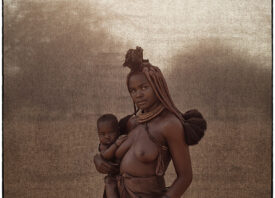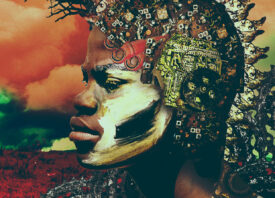Search this site
Vulnerability, Resilience, and Self-Acceptance, Through the Eyes of a Ukrainian Artist


Before he released GIANT, a series of self-portraits, Artem Humilevskyi’s finger hovered over the “publish” button for six hours. It was a personal project that required him to bare all, both physically and philosophically, and he had no way of knowing how people might react. In the end, it was worth the risk. “Hitting that button was a decisive step in the project,” he says. “When I did it, I realized that nothing happened. No one threw stones at me; all the experiences I had dreaded lived only in my head.”
While the decision to share the images might have been difficult, their actual creation was natural and seamless. The project started in March 2020, amid the isolation of the early days of the pandemic. Lockdowns brought fear and restlessness, but they also encouraged Humilevskyi to spend more time with himself. The ideas–and the pictures–flowed from him organically. He didn’t have to look far for inspiration.
He turned his home in Mykolaiv, Ukraine into a playground, staging self-portraits that captured the ambiguous feelings of an unprecedented time: the longing for connection, the anxiety of being cooped up indoors, the beauty hidden in the tiny details of domestic life, and, perhaps most of all, the joy of rediscovering ourselves. The nudity, he says, was never about being naked; it’s about being honest and open–stripping yourself down to the core.
“This project, on the whole, is about self-acceptance,” he tells me. “We all want to look better than we really are, and when we do not meet those expectations, we begin to hate ourselves for our flaws. I wanted to understand who I am and what I am in reality. I wanted to stop sexualizing the body and just see it as a body, an arm as an arm, a leg as a leg. This allowed me to accept myself, and later, to love myself.”
Humilevskyi minted a collection of 50 photographs from GIANT as NFTs on the Foundation platform on February 17th, 2022. One week later, the Russian military invaded Ukraine. Humilevskyi was in Kyiv, preparing to visit a photography exhibition the following day, when the news broke. The artist and his wife and child were forced to leave their home in Mykolaiv to stay with family in the countryside. He hasn’t been able to return, and he doesn’t know when he will.
A week ago, on June 22nd, news has broken that Russia launched seven missiles at the city. At least one person was killed; several fires broke out, and homes, businesses, and a school were damaged. On the 29th, a Russian missile strike on Mykolaiv killed at least three people and wounded at least five.
The city has experienced an onslaught of attacks in recent months, but for many, this place and its people have also come to symbolize hope and defiance. Despite repeated bombings and the relentless violence of their assaults, Russian military forces have failed to capture Mykolaiv.
Humilevskyi’s work has become an emblem of resilience as well; he’s been donating some of the proceeds from his NFT sales to aid hospitals, the army, and people in his community. He’s also working on another self-portrait project, exploring his personal experiences amid the backdrop of global history.

His photographs, while timeless, take on another layer of meaning day by day. In one, the artist is standing in a field of yellow mustard flowers, basking in the light beneath a bright blue sky. The landscape looks like the Ukrainian flag, and Humilevskyi is right there in the middle of it, soaking in the beauty and sunshine.
Humilevskyi says he didn’t choose the locations for the GIANT photographs; instead, they chose him. He looked at his surroundings, and some places called out to him. “I inserted myself into what I saw,” he explains. The picture in the mustard field captures the feeling of being safe and free–the feeling of being at home in both your body and your country.
During the war, Ukrainian families have been separated at border gates around the world. Humilevskyi has been able to stay with his wife and son, and that’s something he doesn’t take for granted. Even in GIANT, a series of self-portraits, you can find traces of his family, from the furniture they have at home to the food they have in their fridge. In one picture, the artist’s son has hopped into the frame himself. His father tells me that, originally, it was supposed to be just him, like all the rest of the images, but his kid insisted. “For him, it is an interesting game,” he says.

Humilevskyi’s wife also plays a prominent role behind the scenes. The most memorable experience they had on a shoot was when they happened upon a burning field. It wasn’t planned; they simply noticed a small dot of glowing light in the distance, hopped in the car, and drove 20 kilometers to find the flames. They had to be careful, and they had very little time, as the fire was fast approaching. In the resulting photograph, lit by the brake lights of the car, the artist looks like the protector of the land–or a phoenix rising from the ashes.

Humilevskyi might say “nothing happened” when he published GIANT, but, of course, that’s not entirely true. The pictures have been shared the world over and bought by some of the most influential art collectors in the space. Though he might have hesitated to publish them initially, the photographs now have a permanent home on the blockchain, where anyone, anywhere, can see and appreciate them.
“I’ve received hundreds of letters from people who suffer from their own insecurities,” the artist admits. “And it’s not just fat people–it can be any kind of insecurity.” Many have found in his work an invitation to express themselves more freely, live more fully, and accept themselves for who they are. “I did not expect my project to become so important to so many people,” he tells me.








All images © Artem Humilevskyi. You can see (and collect) photographs from GIANT over on Foundation.



